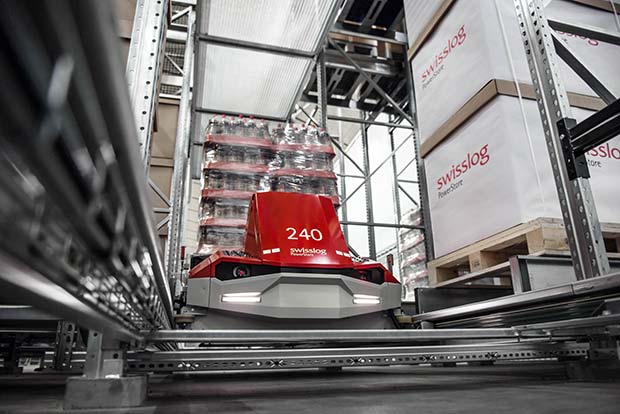It’s no secret that the pandemic changed the nation’s grocery shopping habits. Initially consumers took to online shopping to stock up their fridge-freezers and eat at home, resulting in a huge upward shift in demand. Then grocery sales fell back as people returned to workplace restaurants and physical stores.
 This fluctuation in demand calls for flexible automation in food and beverage logistics. Even more so in temperature-controlled facilities where energy costs are high, and an uncertain labour market is worsened with harsh working conditions.
This fluctuation in demand calls for flexible automation in food and beverage logistics. Even more so in temperature-controlled facilities where energy costs are high, and an uncertain labour market is worsened with harsh working conditions.
Designing a cold store
Traditional warehouses with 40-foot ceiling heights are not suitable for efficient refrigeration, as the square footage of the roof introduces heat from solar energy. A deep-freeze warehouse will also have a heated floor, adding to the heat load.
These issues can be minimized by a taller building design, enabled by automation systems that support vertical storage. Shane Faulkner, Swisslog Head of Sales in the UK explains: “Automation technologies allow you to achieve a footprint approximately one-third of that of a conventional facility.”
The space-saving capabilities of the automation system can result in a reduction of building energy consumption of 20%. “That equates to a 10% to 15% decrease in electrical power draw in the refrigeration system,” says Shane.
Automating to thrive
Cold storage automation should be tailored to product type, throughput, and desired density. It’s also important to consider the automation control platform.
“Stand-alone automation control systems can create data silos, forcing operators to adapt to different interfaces,” Shane explains. “A modular platform that integrates automation control into the WMS platform, such as Swisslog’s SynQ, is much more suitable.” This enables increased use of data for system optimization and business intelligence.
The primary solutions used in deep-freeze or temperature-controlled warehouses include pallet cranes, pallet shuttles, pallet conveyors and automated carton handling systems.
ASRS Pallet Cranes
Stacker crane systems are a cost-effective and reliable approach to enabling high-bay warehouse designs where the highest density and throughput are not required. They enable vertical storage up to 145 feet and allow aisle widths to be reduced from 12 feet to 5 by eliminating the need for forklifts.
“Swisslog’s Vectura high bay warehouse pallet stacker crane has up to 20% lower energy consumption and performs well in temperatures as low as -30°C,” says Shane.
Pallet Shuttle Systems
Robotic pallet shuttles for high-bay storage in deep-freeze and chilled temperature warehouses can store pallet loads in the highest density configurations at heights up to 145 feet. Swisslog’s PowerStore system employs low-footprint pallet lifts in place of aisles to enable storage +20 pallets deep, further improving cold retention.
Pallet Conveyors
Multifunctional conveyor systems provide energy efficient transportation of pallets for both light and heavy loads. “Swisslog’s ProMove pallet conveyor can meet a wide range of requirements for automated pallet transportation and be used in temperatures from -30°C to 50°C,” says Shane.
Automated Carton Handling
Downstream operations within the cold chain warehouse can be automated using robotic case picking systems, such as the Swisslog ACPaQ system. Shane adds: “ACPaQ automates the task of building store-friendly pallets by combining light-goods shuttle systems, conveyors and high-performance de-palletizing and palletizing robotic technology from our parent company KUKA.”
Collaboration is key
“Taking a collaborative approach ensures the building designer can leverage the space and energy-saving capabilities of the automation system, while reducing staff exposure to cold environments,” says Shane. “When supported by advanced energy management strategies that minimize the power draw during peak periods, facilities can achieve new levels of energy and labour efficiency.”
For more about Swisslog automated solutions for temperature-controlled warehouses, visit www.swisslog.com/Temp-Controlled-WLN




Comments are closed.